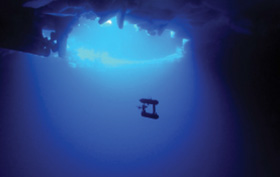AUV and ROV operations under ice
Autonomous and remotely operated vehicles deployed under glacial and sea ice are able to investigate a number of questions related to ice dynamics, ice formation and melting, and under-ice ecosystems that are particularly compelling given recent and continuing changes to Earth’s climate and increased interest in hydrocarbon and mineral extraction in the Arctic. Operating under ice requires solving a number of specialized technical problems, including vehicle reliability, navigation at high latitudes, and communications over long horizontal ranges in highly reverberant acoustic environments.
WHOI currently operates two classes of AUVs under ice—SeaBED and REMUS—to gather data on ice thickness and the physical processes under the ice. These observations complement WHOI’s accomplishments in tethered and moored profiling instruments also routinely deployed on and under the ice. WHOI is also developing a new polar ROV (PROV), designed to transit up to 20 kilometers under sea ice while transmitting high-definition video images over a fiber-optic link that is similar to the one WHOI scientists built to remotely control WHOI’s Nereusvehicle in the Challenger Deep.
Principal Engineers
Hanumant Singh
Associate Scientist with Tenure, WHOI
Andy Bowen
Principal Engineer and Co-Director of National Deep Submergence Facility, WHOI

